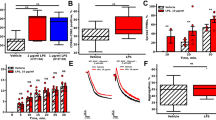Abstract
Circulating thromboxane (TX) is elevated following endotoxin, and platelets become hyperaggregable. Thromboxane synthesis was therefore studied in platelets during endotoxemia. Rabbit blood and platelets were taken at 0, 60 and 120 min after start ofE. coli endotoxin infusion (1.10 μg/kg min, i.v.). Blood incubated with arachidonic acid (AA, 10−4 M) generated TXA2, which was measured using a superfused rabbit aorta bioassay. Washed platelets were stimulated with 1-14C AA (0.1 μCi) to generate radiolabeled TXB2, which was isolated by TLC and quantitated by scintillation spectrometry. Control (0 time) platelet count was 488×103/mm3. In the test group, platelet counts fell to 65% of control at 60 min and to 52% at 120 min, while TXA2 generation was 95% (60 min) and 94% (120 min) of control. In contrast a serial dilution of untreated platelets yielded a progressive decline in thromboxane generation. In endotoxemic platelets, the conversion of 1-14C AA to TXB2 (percent/109 platelets) was increased at 120 min (0 min, 34.7; 120 min, 40.0;P<0.05). Endotoxemic platelets generated greater amounts of thromboxane than did normal platelets, and this condition may account for platelet hyperaggregability in shock.
Similar content being viewed by others
References
M. Hamberg, J. Svensson andB. Samuelsson,Thromboxanes: a new group of biologically active compounds derived from prostaglandin endoperoxides. Proc. Natn. Acad. Sci. USA72, 2994–2998 (1975).
J.A. Cook, W.C. Wise andP.V. Haluska,Elevated thromboxane levels in the rat during endotoxic shock. J. Clin. Invest.65, 227–230 (1980).
D.E. MacIntyre, A.P. Allen, K.J.I. Thorne, A.M. Glavert andJ.L. Gordon,Endotoxin-induced platelet aggregation and secretion, J. Cell Sci.28, 211–223 (1977).
M. Hamberg, J. Svensson, T. Wakabayashi andB. Samuelsson,Isolation and structure of two prostaglandin endoperoxides that cause platelet aggregation. Proc. Natn. Acad. Sci. USA71, 345–349 (1974).
J.M. Bailey, R.W. Bryant, S.J. Feinmark andA.N. Makheja,Differential separation of thromboxanes from prostaglandins by one- and two-dimensional thin layer chromatography. Prostaglandins13, 479–492 (1977).
Author information
Authors and Affiliations
Rights and permissions
About this article
Cite this article
Prancan, A., Simon, D. & Pope, L. Platelet thromboxane production during endotoxin shock. Agents and Actions 11, 648–650 (1981). https://doi.org/10.1007/BF01978779
Issue Date:
DOI: https://doi.org/10.1007/BF01978779




